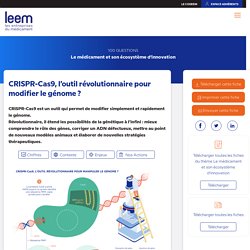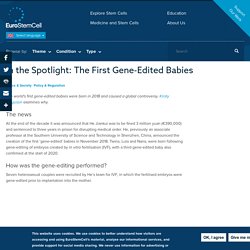

China’s CRISPR twins might have had their brains inadvertently enhanced. “As far as I know, we never heard from him,” says Miou Zhou, a professor at the Western University of Health Sciences in California.

Although He never consulted the brain researchers, the Chinese scientist was certainly aware of the link between CCR5 and cognition. It was first shown in 2016 by Zhou and Silva, who found that removing the gene from mice significantly improved their memory. The team had looked at more than 140 different genetic alterations to find which made mice smarter. Silva says because of his research, he sometimes interacts with figures in Silicon Valley and elsewhere who have, in his opinion, an unhealthy interest in designer babies with better brains.
That’s why, when the birth of the twins became public on November 25, Silva says he immediately wondered if it had been an attempt at this kind of alteration. Whatever He’s true aims, evidence continues to build that CCR5 plays a major role in the brain. Companies declare signs of success in CRISPR treatment of blood disorders. The era of editing human genes to treat inherited disease has arrived.

That’s according to a pair of biotech companies that say they’ve eliminated painful symptoms from two patients with blood diseases. The patients: One has sickle-cell disease and the other suffers from beta thalassemia. For both, the problem is too little hemoglobin, the oxygen carrier in the blood. Earlier this year, each patient underwent an intensive treatment in which doctors collected bone marrow cells and then employed the gene-editing technology CRISPR to turn on a second copy of the hemoglobin gene, normally not active in adults. Then the cells were returned to their bodies. How CRISPR lets you edit DNA - Andrea M. Henle. CRISPR-Cas9, l’outil révolutionnaire pour modifier le génome ? ● Eviter les mutations hors cible : s’il est facile de cibler un gène spécifique avec CRISPR-Cas9, cela peut entraîner d’autres modifications non désirées en d’autres endroits du génome.

Ces mutations non désirées peuvent modifier l’expression de gènes qui n’étaient pas ciblés, les inactiver, voire conduire à l’apparition de cancers. C'est notamment ce qui était arrivé en 2015 lorsque l’équipe de Junjiu Huang, généticien de l’université Sun Yat-sen, dans la province du Guangdong (Chine), avait modifié des embryons humains pour supprimer le gène responsable de la bêta-thalassémie, une maladie du sang.
Des améliorations du système CRISPR-Cas9 permettant de diminuer ces effets indésirables ont déjà été décrites, et de nombreux laboratoires continuent d’y travailler. ● Evaluer l’impact environnemental de la manipulation génétique : l’édition du génome des moustiques est par exemple une solution étudiée pour éradiquer des maladies telles que le paludisme. In the Spotlight: The First Gene-Edited Babies. The world's first gene-edited babies were born in 2018 and caused a global controversy.

Kirsty Ferguson examines why. The news At the end of the decade it was announced that He Jiankui was to be fined 3 million yuan (€390,000) and sentenced to three years in prison for disrupting medical order. He, previously an associate professor at the Southern University of Science and Technology in Shenzhen, China, announced the creation of the first ‘gene-edited’ babies in November 2018. Twins, Lula and Nana, were born following gene-editing of embryos created by in vitro fertilisation (IVF), with a third gene-edited baby also confirmed at the start of 2020. How was the gene-editing performed? Seven heterosexual couples were recruited by He’s team for IVF, in which the fertilised embryos were gene-edited prior to implantation into the mother. Why did this spark a global outcry? CRISPR has revolutionised research in recent years. About Lulu and Nana: Twin Girls Born Healthy After Gene Surgery As Single-Cell Embryos.
UPBM - Opéron numéro 81 (2017-1) Le prix Nobel de chimie 2020 attribué à la Française Emmanuelle Charpentier et Jennifer Doudna. Virtual Lab: Molecular Cloning Virtual Lab. Molecular cloning is one of the techniques that has laid the foundation for modern biotechnology.

The technique was first used in the 1980′s and allowed the insertion of an insulin gene derived from humans to be inserted into yeast and coli bacteria. This allowed the microbes to produce insulin, which is the primary medication in diabetes treatment. Since then, molecular cloning and genetic engineering has become one of the most fundamental techniques ranging from pharmaceutical production, bioethanol production along with medical to basic research. In the Molecular Cloning lab, you will learn how to assemble an expression vector containing RAD52 and GFP.
The aim is to control the expression level of RAD52 with Doxycyline and to monitor the expression level by observing the GFP signal. Vector assembly In the first part of the Molecular Cloning lab, you will learn how to extract DNA from yeast cells and restrict enzyme isolation in DNA from another vector. Transformation. Pourquoi Crispr révolutionne la manipulation génétique.